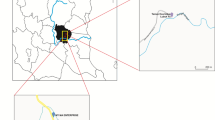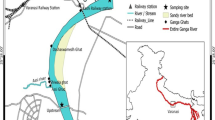Abstract
This study measured eighteen heavy metals and estimated their health risks to humans in the Osun River flowing within the Osogbo metropolis. Seven different river water samples were measured for the metals using inductively coupled plasma coupled with an optical emission spectrometer (ICP-OES). Sixteen metals were detected with concentrations order: Fe > Cu > B > Al > Ba > Mn > Cr > (Co, Pb) > As > V > Ti > Ag > Ni > Tl > Th; Cd and Mo were below the detection limits. While 86.5% of the total concentration (7362 µg/L) was dominantly shared by Fe (46.6%) and Cu (39.9%), all other metals contributed 13.5%. Fe, Cu, and Cr concentrations were more than the Nigerian and international standards for drinking water. Artisanal and farming activities, as well as petroleum products were the dominant sources of the metals as confirmed by statistical analyses. The hazard quotients were < 1.0, indicating the absence of non-carcinogenic risk. However, carcinogenic risk assessment confirmed that three metals surpassed the acceptable carcinogenic risk range: 1.0 × 10–6–1.0 × 10–4. Cr posed a very high risk (6.81 × 10–3–2.62 × 10–1) via ingestion and dermal pathways to adults and children. Arsenic showed carcinogenic risk ((1.41–5.35) × 10–4) by both pathways, except for children by dermal contact. Ni posed a low carcinogenic risk (9.65 × 10–4–1.96 × 10–3) only by dermal exposure. There is a need for legislative policies to prevent waste disposal into the river and an action plan for remediation.



Similar content being viewed by others
References
Adesanya OO, Ogunlaja OO, Agunbiade FO, Ogunlaja A, Unuabonah EI, Adebajo LO (2020) Source identification and human health risk assessment of heavy metals in water sources around bitumen field in Ondo State, Nigeria. Environ Forensics 0:1–12. https://doi.org/10.1080/15275922.2020.1850569
Agyemang J, Gyimah E, Ofori P, Nimako C, Akoto O (2022) Pollution and health risk implications of heavy metals in the surface soil of Asafo auto-mechanic workshop in Kumasi, Ghana. Chem Africa 5:189–199. https://doi.org/10.1007/s42250-021-00297-x
Ahmed ASS, Hossain MB, Babu SMOF, Rahman MM, Sarker MSI (2021) Human health risk assessment of heavy metals in water from the subtropical river, Gomti, Bangladesh. Environ Nanotechnology, Monit Manag 15:100416. https://doi.org/10.1016/j.enmm.2020.100416
Akoto O, Gyimah E, Zhan Z, Xu H, Nimako C (2020) Evaluation of health risks associated with trace metal exposure in water from the Barekese reservoir in Kumasi, Ghana. Hum Ecol Risk Assess an Int J 26:1134–1148. https://doi.org/10.1080/10807039.2018.1559033
Alam L, Alam M, Bin Mokhtar M, Bar A, Kathijotes N, Ta GC, Ern LK (2015) Seasonal variation and preliminary risk assessment of trace element pollution in surface water from Langat River, Malaysia. 10:19–40. https://doi.org/10.31219/osf.io/zj4f6
Alawi MA, Azeez AL (2016) Study of polycyclic aromatic hydrocarbons (PAHs) in soil samples from Al-Ahdab oil field in Waset Region, Iraq. Toxin Rev 35:69–76. https://doi.org/10.1080/15569543.2016.1198379
Ali SY, Sunar S, Saha P, Mukherjee P, Saha S, Dutta S (2021) Drinking water quality assessment of river Ganga in West Bengal, India through integrated statistical and GIS techniques. Water Sci Technol 84:2997–3017. https://doi.org/10.2166/wst.2021.293
Anifowose A. J., Adewuyi A. R., Babalola, O. O., Ajayi, M. T., Adeleke A. E. (2020) Risk assessment of heavy metal pollution of topsoil in the proposed land for UNIOSUN teaching hospital. UNIOSUN J Eng Environ Sci. https://doi.org/10.36108/ujees/0202.20.0290
Anifowose AJ, Oyebode AW (2019) Studies on heavy metals contents of Osun River at the pre-urban settlement and across Osogbo City, Nigeria and across Osogbo City, Nigeria. J Taibah Univ Sci 13:318–323. https://doi.org/10.1080/16583655.2019.1567899
Antoniadis V, Shaheen SM, Levizou E, Shahid M, Niazi NK, Vithanage M, Ok YS, Bolan N, Rinklebe J (2019) A critical prospective analysis of the potential toxicity of trace element regulation limits in soils worldwide: Are they protective concerning health risk assessment? - A review. Environ Int. https://doi.org/10.1016/j.envint.2019.03.039
APHA (2017) Standard methods for the examination of water and wastewater, 23rd. American Public Health Association (APHA), American Water Works Association, Water Environment Federation
ATSDR (Agency for Toxic Substances and Disease Registry) (2012) ToxGuide for Cadmium. Available at: https://www.atsdr.cdc.gov/toxprofiles/tp5.pdf
Bhakar P, Singh AP (2019) Groundwater quality assessment in a hyper-arid region of Rajasthan, India. Nat Resour Res 28:505–522. https://doi.org/10.1007/s11053-018-9405-4
Chowdhury S, Mazumder MAJ, Al-Attas O, Husain T (2016) Heavy metals in drinking water: occurrences, implications, and future needs in develo** countries. Sci Total Environ 569–570:476–488. https://doi.org/10.1016/j.scitotenv.2016.06.166
Dong Z, Qin D, Qin X, Cui J, Kang S (2017) Changes in precipitating snow chemistry with seasonality in the remote Laohugou glacier basin, western Qilian Mountains. Environ Sci Pollut Res 24:11404–11414. https://doi.org/10.1007/s11356-017-8778-y
Gad SC (2014) Barium Encycl Toxicol Third Ed 1:368–370
Giao NT, Anh PK, Nhien HTH (2021) Spatiotemporal analysis of surface water quality in Dong. Water 13:336
Giri I, K.C. R, Khadka UR (2022) Water quality status in Bagmati river of Kathmandu valley, Nepal. In: Ecological significance of river ecosystems. Elsevier, pp 481–502
Inostroza M, Rodríguez-Díaz AA, Aguilera F, Pérez-Zárate D, Menzies A (2021) Evidence of boron-rich aqueous and crystalline phases associated with fumarolic emissions at Guallatiri volcano, northern Chile. J Volcanol Geotherm Res 416:107270. https://doi.org/10.1016/j.jvolgeores.2021.107270
Iqbal J, Shah MH (2013) Health risk assessment of metals in surface water from freshwater source lakes, Pakistan. Hum Ecol Risk Assess 19:1530–1543. https://doi.org/10.1080/10807039.2012.716681
Itodo AU, Sha’ato R, Arowojolu MI (2018) Distribution of polycyclic aromatic hydrocarbons (PAHs) in soil samples from regions around loda-irele bitumen field, Nigeria. Pakistan J Anal Environ Chem 19:71–78. https://doi.org/10.21743/pjaec/2018.06.07
Jiang Y, Chao S, Liu J, Yang Y, Chen Y, Zhang A, Cao H (2017) Source apportionment and health risk assessment of heavy metals in soil for a township in Jiangsu Province, China. Chemosphere 168:1658–1668. https://doi.org/10.1016/j.chemosphere.2016.11.088
Kamzati LLJ, Kaonga CC, Mapoma HWT, Thulu FG, Abdel-dayem SM, Anifowose AJ, Chidya RCG, Chitete-Mawenda U, Sakugawa H (2020) Heavy metals in water, sediment, fish and associated risks from an endorheic lake located in Southern Africa. Int J Environ Sci Technol 17:253–266. https://doi.org/10.1007/s13762-019-02464-7
Kumar A, Matta G, Bhatnagar S (2021) A coherent approach of water quality indices and multivariate statistical models to estimate the water quality and pollution source apportionment of River Ganga System in Himalayan region, Uttarakhand, India. Environ Sci Pollut Res 28:42837–42852. https://doi.org/10.1007/s11356-021-13711-1
Laxmi V, Kaushik G (2020) Toxicity of hexavalent chromium in environment, health threats, and its bioremediation and detoxification from Tannery wastewater for environmental safety. In: Saxena G, Bharagava RN (eds) Bioremediation of industrial waste for environmental safety. Springer Singapore, Singapore, pp 223–243. https://doi.org/10.1007/978-981-13-1891-7_11
Leyssens L, Vinck B, Van Der Straeten C, Wuyts F, Maes L (2017) Cobalt toxicity in humans—A review of the potential sources and systemic health effects. Toxicology 387:43–56. https://doi.org/10.1016/j.tox.2017.05.015
Moskalyk RR, Alfantazi AM (2003) Processing of vanadium: A review. Miner Eng 16:793–805. https://doi.org/10.1016/S0892-6875(03)00213-9
Nielsen DL, Brock MA, Rees GN, Baldwin DS (2003) Effects of increasing salinity on freshwater ecosystems in Australia. Aust J Bot 51:655. https://doi.org/10.1071/BT02115
Nkpaa KW, Amadi BA, Wegwu MO (2018) Hazardous metals levels in groundwater from Gokana, Rivers State, Nigeria: Non-cancer and cancer health risk assessment. Hum Ecol Risk Assess 24:214–224. https://doi.org/10.1080/10807039.2017.1374166
NSDWQ (Nigerian Standard for Drinking Water Quality) (2015) Nigerian Industrial Standard (NIS). Approved by the Standard Organisation of Nigeria 554:1–28. Available at https://rivwamis.riversstate.gov.ng/assets/files/Nigerian-Standard-for-Drinking-Water-Quality-NIS-554-2015.pdf
Peng C, Cai Y, Wang T, **ao R, Chen W (2016) Regional probabilistic risk assessment of heavy metals in different environmental media and land uses: an urbanization-affected drinking water supply area. Sci Rep 6:1–9. https://doi.org/10.1038/srep37084
Praveena SM, Omar NA (2017) Heavy metal exposure from cooked rice grain ingestion and its potential health risks to humans from total and bioavailable forms analysis. Food Chem 235:203–211. https://doi.org/10.1016/j.foodchem.2017.05.049
Rezaei H, Zarei A, Kamarehie B, Jafari A, Fakhri Y, Bidarpoor F, Karami MA, Farhang M, Ghaderpoori M, Sadeghi H, Shalyari N (2019) Levels, distributions and health risk assessment of lead, cadmium and arsenic found in drinking groundwater of Dehgolan’s villages. Iran Toxicol Environ Health Sci 11:54–62. https://doi.org/10.1007/s13530-019-0388-2
Shrivastava A, Gupta V (2011) Methods for the determination of limit of detection and limit of quantitation of the analytical methods. Chronicles Young Sci 2:21. https://doi.org/10.4103/2229-5186.79345
Sibal LN, Espino MPB (2018) Heavy metals in lake water: a review on occurrence and analytical determination. Int J Environ Anal Chem 98:536–554. https://doi.org/10.1080/03067319.2018.1481212
Singh AP, Dhadse K, Ahalawat J (2019) Managing water quality of a river using an integrated geographically weighted regression technique with fuzzy decision-making model. Environ Monit Assess. https://doi.org/10.1007/s10661-019-7487-z
Sutherland RA (2000) Bed sediment-associated trace metals in an urban stream, Oahu. Hawaii Environ Geol 39:611–627. https://doi.org/10.1007/s002540050473
Titilawo Y, Adeniji A, Adeniyi M, Okoh A (2018) Determination of levels of some metal contaminants in the freshwater environments of Osun State, Southwest Nigeria: A risk assessment approach to predict health threat. Chemosphere 211:834–843. https://doi.org/10.1016/j.chemosphere.2018.07.203
Tong X, Chen X, Chuang H, Cao J, Ho SSH, Lui K, Ho KF (2019) Characteristics and cytotoxicity of indoor fine particulate matter (PM2.5) and PM2.5-bound polycyclic aromatic hydrocarbons (PAHs) in Hong Kong. Air Qual Atmos Heal 12:1459–1468. https://doi.org/10.1007/s11869-019-00762-0
USEPA (2004) Risk assessment guidance for superfund (RAGS). Volume I. Human health evaluation manual (HHEM). Part E. Supplemental guidance for dermal risk assessment. US EPA. EPA/540/1-89/002
USEPA (2006) Freshwater screening benchmarks. EPA Region III BTAG, 7/2006. Available at https://www.epa.gov/sites/default/files/2015-09/documents/r3_btag_fw_benchmarks_07-06.pdf
USEPA (2015) Regional screening table. USEPA Washington, DC. Available at https://www.epa.gov/risk/regional-screening-levels-rsls-generic-tables
Wang Y-B, Liu C-W, Kao Y-H, Jang C-S (2015) Characterization and risk assessment of PAH-contaminated river sediment by using advanced multivariate methods. Sci Total Environ 524–525:63–73. https://doi.org/10.1016/j.scitotenv.2015.04.019
Wang G, Liu H-Q, Gong Y, Wei Y, Miao A-J, Yang L-Y, Zhong H (2017a) Risk assessment of metals in urban soils from a typical industrial city, Suzhou, Eastern China. Int J Environ Res Public Health 14:1025. https://doi.org/10.3390/ijerph14091025
Wang J, Liu G, Liu H, Lam PKS (2017b) Multivariate statistical evaluation of dissolved trace elements and a water quality assessment in the middle reaches of Huaihe River, Anhui, China. Sci Total Environ 583:421–431. https://doi.org/10.1016/j.scitotenv.2017.01.088
Weldeslassie T, Naz H, Singh B, Oves M (2018) Chemical contaminants for soil, air and aquatic ecosystem. In: Oves M, Zain Khan M, M.I. Ismail I (eds) Modern age environmental problems and their remediation. Springer International Publishing, Cham, pp 1–22. https://doi.org/10.1007/978-3-319-64501-8_1
WHO (World Health Organization) (2011) Guidelines for Drinking-water Quality. Available at https://apps.who.int/iris/bitstream/10665/44584/1/9789241548151_eng.pdf
Wilson L (2012) Toxic metals and human health. Toxic Met Hum Heal Dis 2nd ed Mex Eck Inst Nutr Bioenerg 1–37.
**ao J, Wang L, Deng L, ** Z (2019) Characteristics, sources, water quality and health risk assessment of trace elements in river water and well water in the Chinese Loess Plateau. Sci Total Environ 650:2004–2012. https://doi.org/10.1016/j.scitotenv.2018.09.322
Yu FC, Fang GH, Ru XW (2010) Eutrophication, health risk assessment and spatial analysis of water quality in Gucheng Lake, China. Environ Earth Sci 59:1741–1748. https://doi.org/10.1007/s12665-009-0156-8
Zeng X, Liu Y, You S, Zeng G, Tan X, Hu X, Hu X, Huang L, Li F (2015) Spatial distribution, health risk assessment and statistical source identification of the trace elements in surface water from the **angjiang River, China. Environ Sci Pollut Res 22:9400–9412. https://doi.org/10.1007/s11356-014-4064-4
Zhao YP, Tang YJ, Xu J, Zeng Z, Ying JF, Tian HC, Huang F (2021) Barium isotope evidence for recycled crustal materials in the mantle source of continental basalts. Lithos 390–391:106111. https://doi.org/10.1016/j.lithos.2021.106111
Author information
Authors and Affiliations
Corresponding author
Ethics declarations
Conflict of interest
The authors declare no competing financial interests or personal relationships could have appeared to influence the work reported in this paper.
Additional information
Publisher's Note
Springer Nature remains neutral with regard to jurisdictional claims in published maps and institutional affiliations.
Rights and permissions
Springer Nature or its licensor (e.g. a society or other partner) holds exclusive rights to this article under a publishing agreement with the author(s) or other rightsholder(s); author self-archiving of the accepted manuscript version of this article is solely governed by the terms of such publishing agreement and applicable law.
About this article
Cite this article
Anifowose, A.J., Salawudeen, C., Osundiya, F.O. et al. Estimation of health risk to humans and source identification of heavy metals in a perennial river across the Osogbo Metropolis, Nigeria. Environmental Sustainability 6, 45–58 (2023). https://doi.org/10.1007/s42398-022-00256-3
Received:
Revised:
Accepted:
Published:
Issue Date:
DOI: https://doi.org/10.1007/s42398-022-00256-3




